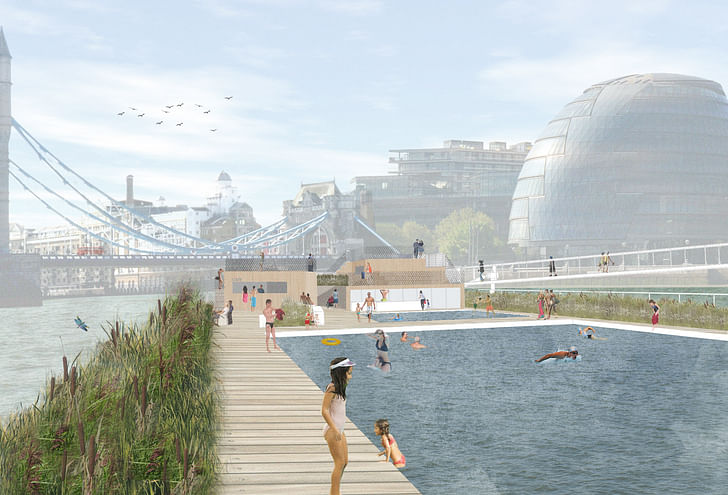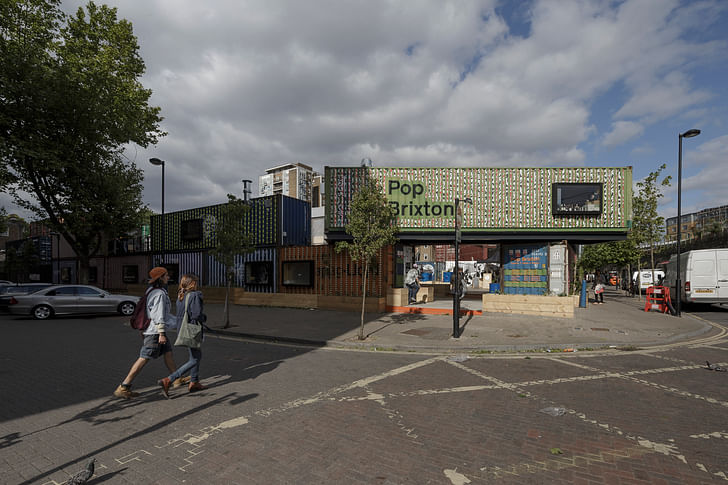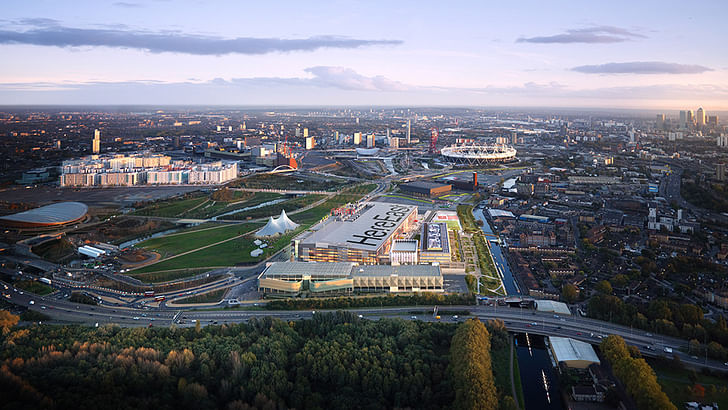

It's that time again – the fresh slate of a new year, the bloat of holidays past and the intent to make good on promises to oneself. Evolution through resolution. Before Christmas, I'd attended a talk organised by London’s Museum of Architecture entitled “Alternative Careers in Architecture,” with guest speakers Chris Romer-Lee, director and co-founder of Studio Octopi and Carl Turner of Carl Turner Architects. The event was a perfect opportunity for reflection on career progress, work-life management and future ambitions – the main points of which are served up here, in three parts.
After the talk, I also spoke with attendees Sara Darwin of Phi Architects and Roger Hawkins of Hawkins\Brown, to ask for their advice as well. The two architectural practices work at vastly different scales: Hawkins\Brown is 27 years old and has 208 staff between London and Manchester, with room to grow, while Phi Architects is a deliberately smaller practice consisting of Darwin, a friend and a number of freelancers. Together, all of these firms provided valuable insight into alternative work happening in the UK – they're not quite Working Out of the Box, but their paths have branched into new, somewhat unexpected territories as they gather more experience.

Part I: Competition and Community with Thames Baths and Pop Brixton
The talk given by Romer-Lee and Turner revolved around two self-initiated projects, born on the back of competitions. For Romer-Lee, Thames Baths began in 2013 as part of the "London As It Could Be Now" programme. This was an open call ideas project, developed by The Architecture Foundation and Royal Academy of Arts with Rogers Stirk Harbour + Partners.
Thames Baths proposes the reintroduction of swimming in the River Thames, something that, believe it or not, was a flourishing activity in the Victorian era. Romer-Lee had the idea while lazing by Lake Zurich in Switzerland, watching urban swimmers in one of the many lakeside lidos. As well as being an architectural consideration, the project has become one of design management, provoking imagined possibilities for the future of the river and internal revelations of a fresh approach to business.
Initially funded from the studio's pocket, the project has since been injected with nearly £143,000 from a Kickstarter campaign (they had asked for only £125,000), and a CIC (Community Interest Company) was set up to make sure funds were properly allocated. But the interest in the project isn't just reflected in the over-reaching cash targets. Romer-Lee points to the iconic status of the underused commodity as an opportunity: "We are talking about London's largest public space; it's seven times the size of Hyde Park. We've been cut off from the river, now we propose to re-engage."
stop thinking and being an architect and think about dominationThe Thames Baths team, put together from employees at Studio Octopi and elsewhere, then set about capturing the public imagination with a series of widely circulated concept drawings. An aggressive PR campaign sought out ambassadors, including keen swimmer and artist Tracey Emin CBE, to add weight to the proceedings. Romer-Lee cites the inclusion of outside influences, such as strategy director Matt Bamford-Bowes, as fundamental to a shift in thinking on how self-initiated architectural projects can be accomplished.

"Matt taught me to stop thinking and being an architect and think about domination,” Romer-Lee said. “Architects are obsessed about one product, Matt told us to think bigger and see the project as a business ecosystem, replicable on many sites." This thinking has moved the concept from one-off architectural monolithic to a series of branded natural swimming baths along the Thames.
when do architects stop when they are the client as well?Romer-Lee has also had the opportunity to self-reflect on the balance of power for self-initiated projects: "As architects and developers we are constantly changing the design, which leads us to ponder: when do architects stop when they are the client as well?"
Turner spoke of his Pop Brixton project, the result of a competition put forward by Lambeth Council to re-energise a derelict space in the heart of Brixton with a temporary community space, earmarked for redevelopment in 2017.
being an architect isn't a serious occupation.Based in Brixton, South London, Carl Turner Architects is a studio of 12 people with a maverick, art house sense of duty. "We are designers, but we are makers. I studied at the Royal College of Art, we built for others when times were hard and buying and selling property has helped me run a practice," said Turner, before delivering the punchline: "being an architect isn't a serious occupation."
Turner is serious, however, about using architecture as a tool for delivering a better world. "I saw an article for Lambeth open call, a two-year project for an idea for a site in the middle of Brixton. The council were looking for ideas that would create opportunities for the local community; we'd done Hackney City Farm office for £7,000, demonstrating community, so we thought we'd go for it," said Turner. "We started off with a sketch, we went to see the council, they said they liked it and we were shortlisted. It was basically a load of shipping containers, but it was also about creating a place and a space. Then, we won it. Then we had to do it."

This spur of the moment application led to a collaboration with not only Lambeth Council but also The Collective, RIBA, Lambeth College, Vital Arts and TEDx Brixton to form Pop Brixton, which provides 50 units for small businesses with over 200 jobs created on site since May 29, 2015.
Pop Brixton is a “load” of shipping containers based around a central courtyard, true to Turner’s vision. Spaces for casual dining and socialising mix with small start-up enterprises, retail, music studios and a new radio station. The site has not been without its critics. Brixton is on the front lines of an uneasy gentrification process that has seen local community jolted by new wealth and hipster vibes. Pop Brixton has been unfairly compared to BOXPARK Shoreditch, which also utilises shipping containers, but Pop Brixton is a truly community-spirited place – when Adidas paid a stack of cash to use the space, Pop Brixton put all the money towards starting up the aforementioned local radio station.

"Up until then, we'd built houses. The naivety allows you freedom," said Turner. However, what Turner was creating was not only a literal market stall, but a figurative one as well – setting up a relationship and gaining the trust of authority.
"Now [that] we're much more mixed-use, we're now shipping containers experts," said Turner with a wry smile, adding, "there has been an obsession for last 10 to 15 years for new shapes built with the wrong materials, that's why the general public are disengaged. We are not building what people want. It's not about creating new big buildings or statements; we are not building for 300 years. London is a fast evolving city."
Do it early and fail cheap.Since Pop Brixton, the studio has gone on to work on Peckham Square Co-Design, a project commissioned by Southwark council to envision a better future for Peckham Square in South London.
The scope of the project has grown to a “micro plan” consisting of small separate sites, which sound suspiciously “container-esque,” although Turner is keen to point out the plans are for actual buildings rather than pre-used boxes. The studio is also looking at a site in Silvertown in East London, a 1,000 unit site of workshops, using containers as a tool. 2016 is looking very positive for the studio.
What advice can Turner share about his experience? "Do it early and fail cheap. Having built 50 to 60 small projects, for me it's been about building up confidence over time, not doing it all super young. Something like Pop Brixton is closest I've come to a college brief and it paid off."
Part II: Pivoting into Passivhaus
While both Chris Romer-Lee and Carl Turner are seasoned business owners (Studio Octopi was founded in 2003 and Carl Turner Architects in 2006), Sara Darwin left a steady gig in just 2012 to co-found Phi Architects with long-time friend Claire Jamieson. The firm is built around the Passivhaus approach, and both Darwin and Jamieson are Certified Passivhaus Designers through BRE, the Building Research Establishment Passivhaus Designer Course.
I spoke to Darwin about veering away from a steady income as an associate architect to take up study, collaborate with a friend and set up business.
Robert Urquhart: Have your ideals changed since college?
Sara Darwin: From leaving college, I always wanted to work on socially responsible projects, community-based, always with an environmental emphasis, and I suppose the you need to keep following the things that inspire you.environmental side of things has grown more over the years. I really feel like I have done what I wanted to do, and I guess just leaving and going on my own has meant that I specialised more as I've got older. I think the key thing is that you need to keep following the things that inspire you.
What's it like working with one of your best friends?
It's great because we know how to communicate, but we do work on our own projects most of the time. It's more like technical and moral support really, we've always kept in touch and when Claire moved up to Harrogate and then I moved up to Manchester from London we did the Passivhaus course and qualified together. We keep each other up to date on things, go to conferences together and we bid for work together.
Had you always wanted to set up your own practice?
No not at all, quite the opposite. I didn't really want to have that responsibility; I liked the idea that you go home at the end of the day and it's not your worry or your burden, you get paid regularly. But as a female architect, I've worked for a long time, part-time, ever since I've had children. Claire had been working for herself and for a while I was working at a practice in Manchester and then I just decided to take the leap as well.
What part did personal finances play in your career decisions?
I think it really is mixed. I know that lots of people say all architects want to work for themselves but I don't think that's necessarily the case, I think that a lot of it is financial because unless you've got the big project to make the break, it’s quite a risky business to be in.
The reason why I didn't go solo earlier was because financially, my husband and I needed to know we were earning an amount of money each month. The only reason I was able to stop working for someone else and start working for myself was because our financial situation improved. My husband is also an architect, but he works on large-scale commercial projects. It suits family life a lot better for me to work from home; we came to a point that I was able to and just build up my work.
Has being affiliated with a larger standards organisation through Passivhaus been a help or a hindrance?
When Claire first told me about Passivhaus, my comments to her were what a lot of people said at the time: that it was too onerous and restrictive for UK homeowners. But then I learnt more about it and it just seemed to me to be the most logical way to be building things – and also for private houses, which is what we were both going towards. The self-build market is the most adventurous.
find out what you really enjoy doing and try to specialize; try to have a unique angle.Passivhaus is still niche but I've just done a feasibility study for a council for about 20 houses, so that for me is a great step up project-wise, and that's simply because they put a tender out to Passivhaus consultants. I think specialising is a great way to set yourself apart slightly from everybody else. It's really a case of find out what you really enjoy doing and try to specialize; try to have a unique angle.
Even with the support of family and friends isn't it daunting striking out alone? How do you manage to acquire the skills and scale up for projects?
A lot of people, like Claire and I are now, are working individually and coming together for projects – you don't have to be in the same office and I really like that idea. I work with a structural engineer locally, I can pull together people if I need to. There are a lot of people working for themselves now in other disciplines ... Collaboration becomes your office that you can work with: I speak to a lot of people, I just don't work in one room with them all at the same time.

Part III: Tailoring a future from two pasts
My last piece of career-progress advice came by way of Roger Hawkins, co-founder of Hawkins\Brown, based in London and Manchester. Since getting started in 1988, the firm has grown into a 198-strong team and won, or been on the shortlist for, over 120 awards – they've won both the Practice of the Year and the Employer of the Year awards from the Architects' Journal, and were shortlisted for the Stirling Prize.
define the marketplace that you want to work in and focus on that.Talking to Hawkins brings over 27 years of experience to the table. "When we set up in ‘88, we took advice from other young practices who were starting out, who'd maybe done the move a few years ahead of us," said Hawkins. "We just got a feel for what they were doing. It seemed to us, quite early on that how you laid out your stall, how you approached your work, would be pretty key to the type of work you got."
How did Hawkins\Brown get to work on projects such as large scale infrastructure and transport systems right from the very start of their partnership? "Our prior experience," said Hawkins. "We'd been four years working at another practice. Russell and I had worked on large commercial projects – university projects, I'd worked on a railway station – so, when we set up we continued with that level of experience: we marketed ourselves based on that experience. If you look at the success of our business, it’s been in railway stations and university projects and large scale commercial work, which is what we set out to do, so I think the key piece of advice there is to define the marketplace that you want to work in and focus on that."
being an architect is being part of a process, so you need to understand the entire process.And so far, that strategy has panned out well. The company has over 50 large-scale projects currently underway, one of which is Here East, the reworking of the old 2012 Olympic media centre in Stratford in East London, spanning 1.2 million square feet of space. "No one really knew how this building was going to be put back into use, so we've been appointed to work up a master plan and we're now delivering the building," said Hawkins. Hawkins refers to “we” with zeal – he is obviously very proud, not just of his studio team, but of everyone Hawkins\Brown collaborates with.
"We're co-operating with graphic designers and PR people promoting the building and there is a whole range of people working on it,” enthused Hawkins. “But one of our team, Jake, has really got into computer coding and parametrics and so we've learnt from him, one of the youngest guys in the office.”

But what happens when employees choose to leave? "People are leaving to go and become clients," explained Hawkins. "I think that's quite interesting; as the profession grows and the role of an architect changes, I think to be an educated client is quite an important requirement in the build process. A lot of delivery now and a lot of procurement is based on fairly technical support from a contractor."
Finally, what words of advice has Hawkins got for his fellow employers? "Core architectural skills are making places and making spaces work," Hawkins said. "Architects are not just trained as technicians; we've got to get the balance right. A lot of my peers want to take architects out of school and sit them at a desk and get them drawing but I disagree – being an architect is being part of a process, so you need to understand the entire process."
Robert studied fine art and then worked in children's television as a sound designer before running an art gallery and having a lot of fun. After deciding that writing was the overruling influence he worked as a copywriter in viral advertising and worked behind the scenes for branding and design ...
1 Comment
defining your marketplace i think is key, finnally getting there
Block this user
Are you sure you want to block this user and hide all related comments throughout the site?
Archinect
This is your first comment on Archinect. Your comment will be visible once approved.